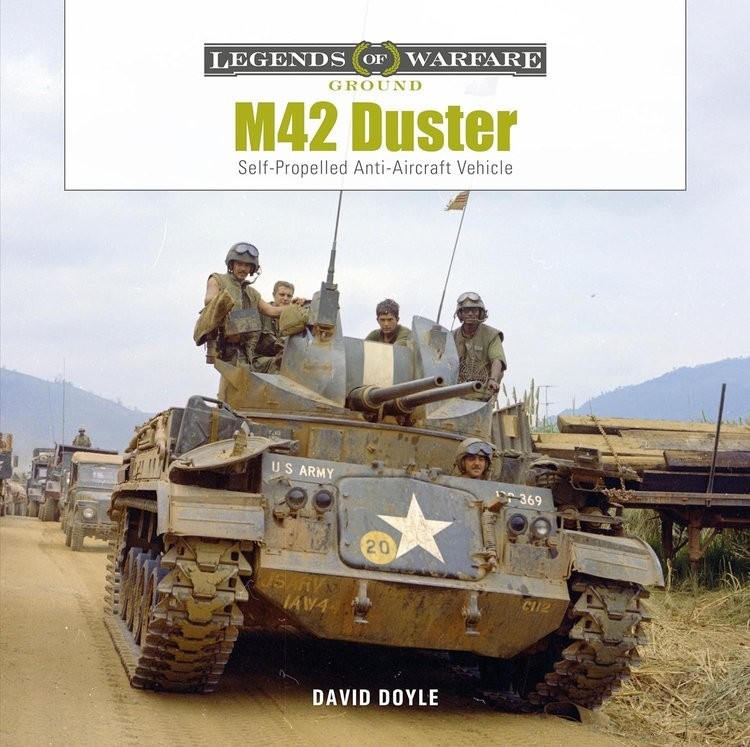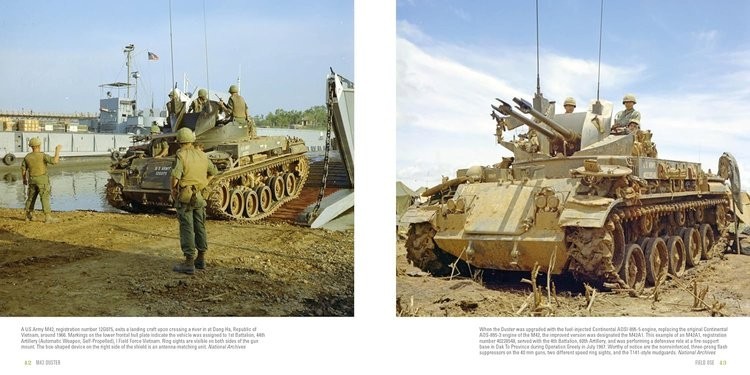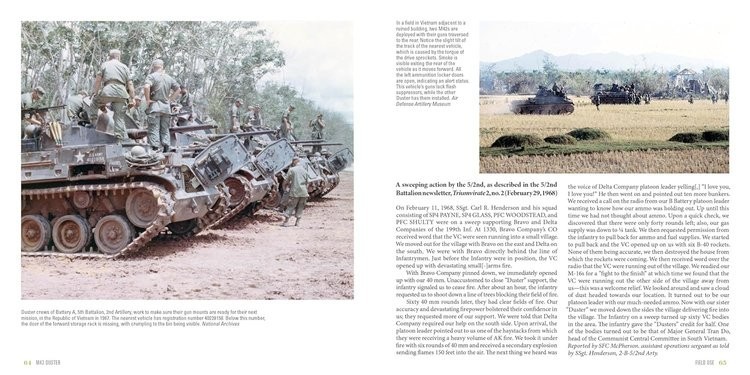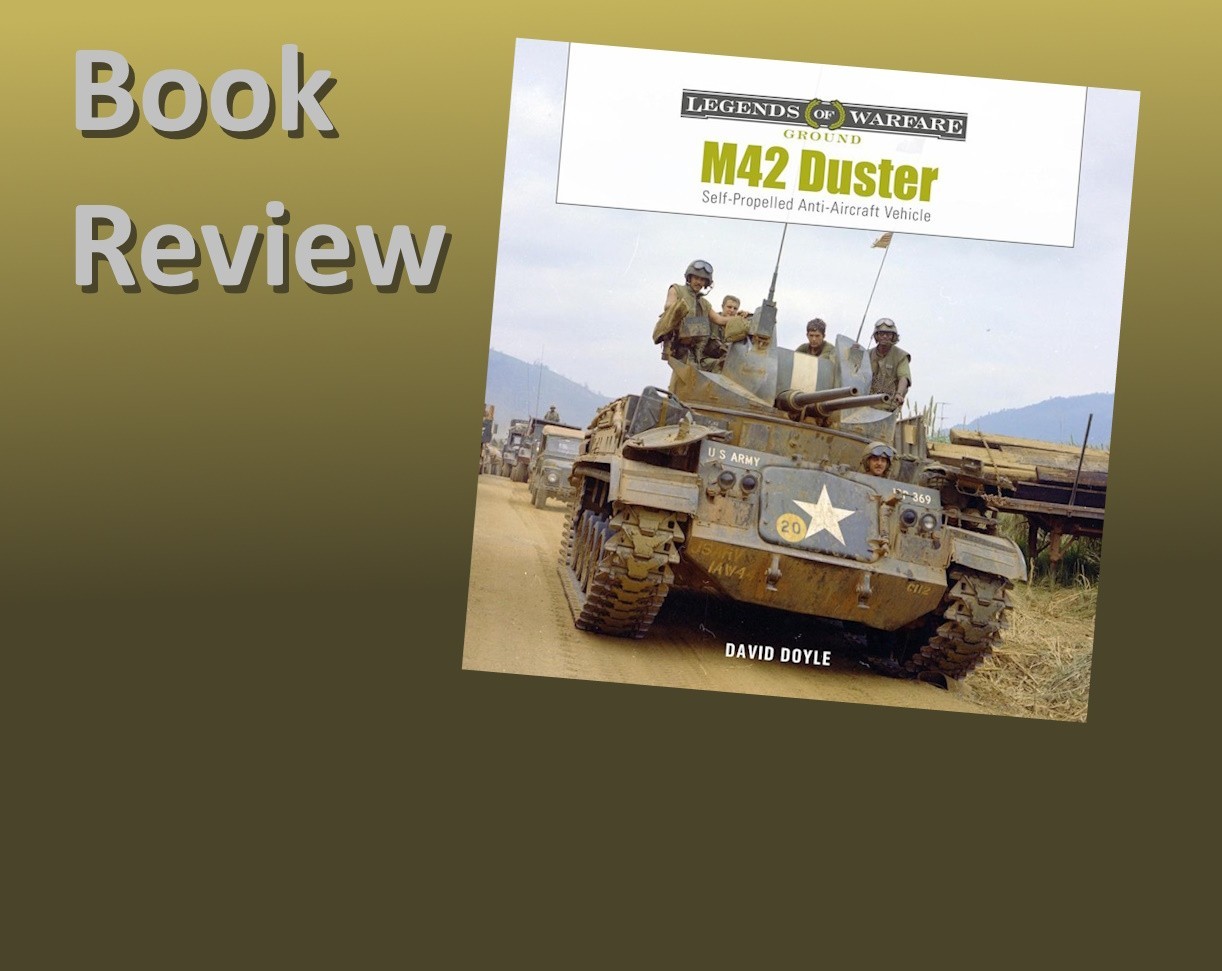
Introduction
M42 Duster: Self-Propelled Antiaircraft Vehicle is a new title from David Doyle, part of Schiffer Publishing’s series "Legends of Warfare (Ground)." This pictorial book chronicles the M42 from Bofors mounted on half-tracks, to the M19 gun motor carriage, through the M42A1. This hardback book measures 9"x9", features 144 semi-gloss pages with over 300 color or black-and-white photographs, and is catalogued with ISBN 978-0-7643-6782-3. Schiffer Publishing, Ltd. is the publisher and the book is also available at a discount from the author at DavidDoyleBooks.com.
Legends of Warfare is a series of books of standard size, layout, and range from 112 to 144 pages in length. They have a clean look to them and thus easy to read and learn from. Whether your interest is modeling, history or restoration, the focus is on the evolution and variant details of the M42.
The genesis of David Doyle Books began while restoring military vehicles, while at the same time working in a hobby shop. Thus, his keen emphasis on what so many people of those communities value about his work.
Contents
M42 Duster: Self-Propelled Antiaircraft Vehicle is told through 144 pages with three chapters and an introduction:
1. Production (12 pages)
2. Field Use (82 pages)
3. The Duster in Detail (38 pages)
Introduction and Production recount the need for mobile antiaircraft support and attempts to create a suitable vehicle. The M24 Chaffee chassis received a turret with two 40mms and operated in the last days of World War Two as the M19. The author continues to explain what became the T141 until contract DA-20-089-ORD-2931 started the ball rolling, which eventually became the M42. As with other David Doyle books I have seen, he includes contract numbers, monetary appropriations, dates and changes and reasons for the design. We are treated to photos of the mock-ups and inside of assembly halls. The progression of the M42 is shown through images and described in captions. These include at the factory and test ranges, and grinding and splashing around Fort Knox on a bright clear winter day. Detailed descriptions fill the text, e.g., hooks attached to the sides, the number of links per track, how many seconds to rotate the turret 360-degrees.
Field Use continues the same level of detail. This chapter describes the composition of M42 batteries, including other weapon systems deployed with Dusters. In one page of text we learn which formations were equipped with Dusters before, and after, deployment to Vietnam, and tours of duty for crews. The chapter presents several notable Duster battles:
- The First Major Duster Battle of the Vietnam War: US Forces Defend Camp J. J. Carroll.
- The Battle at Phu Tho Racetrack in Saigon, February 1968.
- A sweeping action by the 5/2nd, as described in the 5/2nd Battallion newsletter, Triumvirate 2, no. 2 (Feb. 29, 1968)
- The Last Duster Battle: Dusters Fight Alone as Described by Paul Kopsick, B/4-60 ADA, 1971
The rest of the chapter's story is told through photos with captions, many of which are a story in themselves.
In The Duster in Detail, those 38 pages are full of high-quality color photos of restored M42s. Each page contains one to four photos. They start where the track meets the dirt and work all the way up, looking at the whole vehicle to minute details. Modelers can check the real thing with kit parts, i.e., are the return rollers really that bad?
Photos
As with the M48 book, I did not count the advertised 300+ color or black-and-white photographs but would not be surprised if there are a few more. The gallery is excellent, many being professionally exposed. Even amateur "grab shots" or "in-action" exposures are clear and well developed. I did not notice any that are fuzzy. There are a few with deteriorating color, something common to Kodak films of the 1950s-70s, i.e., Kodak Kodacolor.
Subjects include M42s in production, in service, in action, and on display. The several restored M42s were apparently photographed with modelers in mind, noting subtle details of the Duster, e.g., waffle pattern on the gun shield armor, numerous unpainted padlocks, stowed turret seats. Mud and dust patterns? Crew stowage tastes? Photographic evidence is provided. The author shot numerous views of all areas and components of restored M42s, including driver compartments.
Several wartime photos show Dusters with varying degrees of combat damage. A sample of photos I think are particularly interesting, inspirational, and educational for modelers are:
- M42 chassis undergoing heavy maintenance on its side in a powerful rotating jig.
- Marine Corps M42s.
- Crews stuffed into the turret.
- "Glamour portrait" of fresh 12D320, late-production M42, at Detroit Arsenal, on the day of my birth.
- Dusters in Alaska with a variety of winter camouflage.
- M42s equipped with grenade catchers.
- Rolling off an LCM onto a Vietnam river bank.
- M42 sandbagged bunkers.
- Changing out an engine.
- M42s on fortified rafts for floating fire support.
- M42 on a Vietnamese dirt road surrounded by green jungle (I find this particularly interesting for diorama reference in the contrast of the olive drab of the vehicle, the green of the jungle, and the color of the road).
- Removing the M21 40 mm gun from a Duster turret.
- M42 mired in a flooded roadside canal.
- M88 recovery vehicle lifting a destroyed M42 onto a truck.
- Another M42 mired in a flooded creek.
- Crewman in a hammock strung alongside a M42.
Artwork
Several illustrations reinforce the photographic content, including full-color renderings.
1. M42, Line art: profile, planform, front and rear.
2. Two M42s illustrated in color, front and profile: "Born to Wonder" in 1968; M42A1 near Dong Ha, 1969.
3. Two M42s illustrated in color, from front and profile: Bundeswehr, 1973; Japanese Self-Defense Force, Okinawa, 1970.
Table
General data covers thirteen characteristics of the M42 and M42A1, and six for their engines:
- Weight
- Maximum towed load
- Length
- Width
- Height
- Track
- Track width
- Maximum speed
- Fuel capacity
- Range
- Electrical
- Transmission speeds
- Turning radius feet
- Engine make/model
- Number of cylinders
- Displacement
- Horsepower
- Torque
- Governed speed
The breadth of imagery makes this an exceptional resource for M42 modelers, whether your subject is the ancient Roco MiniTank, the antiquated Renwal or Tamiya kits, or the newer AFV Club kit - out of the box or superdetailed.
Excellent photography

In the field

Detail views of restored M42

Period photo and color artwork

Factory and concept views

Conclusion
Both Tamiya's and Renwal's M42 Duster were two of my first models and favorites and thus, I will build them again. And when I do, M42 Duster: Self-Propelled Antiaircraft Vehicle will be on the bench. I think this book is a great source for modelers who want to build a detailed Duster, seek diorama ideas, to perfect weathering, and better understand the vehicle. The gallery of photographs are exceptional, many being supplied by Vietnam vets. You will see M42s deployed around the globe, from the jungle, to deserts, to cold climates. Those of the historical mindset will appreciate the bureaucratic details.
I am impressed with this book and recommend it.
Please remember to mention to David Doyle Books, Schiffer Publishing, and retailers that you saw this book here - on Armorama.



























